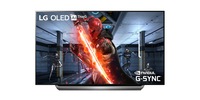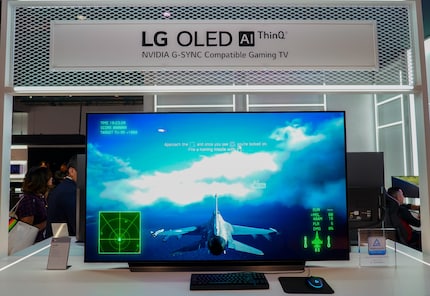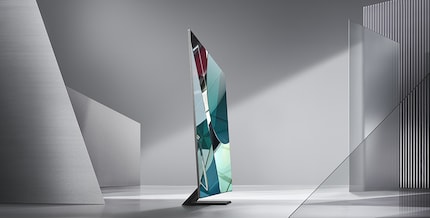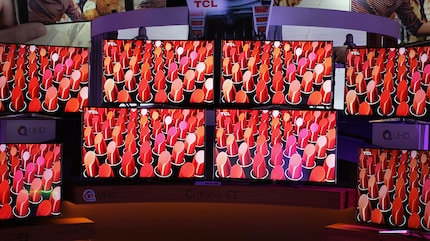
News + Trends
Gaming TV: LG's OLED TVs feature NVIDIA G-Sync
by Luca Fontana

At this year’s CES in Las Vegas, TV manufacturers presented their innovations for 2020 and cast a glance into the future. The predominant technologies are 8K, Micro LED and Mini LED.
If you want to know what the TV industry has up their sleeve for the years to come, it's worth taking a look at CES in Las Vegas. The technology and innovation trade show is not only a jolly product show but also a benchmark for innovations and trends.
Accordingly, LG, Samsung, TCL and the like focussed on 8K, Micro LED and Micro LED. Time to take a closer look.
Surprisingly, it wasn't the Z Series – which stands for LG's 8K OLED TVs – that caused the biggest stir at LG's CES stand. Instead, it was the «small» 48-inch model of the C Series that stood out – LG's flagship OLED series with UHD resolution.
The reason? OLED televisions, although superior, are also much more expensive than LCD TVs. With the 48-inch version, prices are expected to shrink. The smallest OLED size to date was 55 inches – but LG has not yet provided any concrete figures. The 48-inch CX is not only intended for the general public. According to LG, the new OLED TV is also great for gamers, suitable for bedrooms and hobby rooms or for small apartments that simply don’t have the space to accommodate a 65-inch monster.

From the C Series upwards – that’s the C, G, W and Z Series – all OLED TVs are equipped with the exact same panel and third generation Alpha-9 processor. Generation equipped! AI Picture and Sound, two features that were already available last year, have allegedly been improved: an artificial intelligence recognises the content and adjusts the image and sound settings accordingly. For example, when you’re watching a horror movie or the coverage of a sports event. The same is in store for Dolby Vision content and is expected to include additional information such as ambient light: Dolby Vision IQ. However, this is not a manufacturer-specific feature – Panasonic is also set to master Dolby Vision IQ.
Also available ex-factory: G-Sync and HDMI 2.1. Yes, this already existed last year, but only after a firmware update and after half the year was already up. This means that all new OLED TVs are thus perfectly equipped for future console and graphics card generations.
But frankly, none of it sounds very innovative to me. I'm still waiting for the rollable OLED television – the R series. After all, its market launch was planned for last year. This year will be the year, says LG. There was no exact date given, but the South Korean manufacturer did present an OLED that can be rolled down from the ceiling. Great.
Fortunately, when it comes to 8K TVs, LG has a bit more news. In addition to the Z Series for OLEDs, LG also has 8K Nanocell TVs – namely the Nano95, Nano97 and Nano 99 models. Incidentally, the LCD technology behind Nanocell is what Samsung's marketing department calls «Quantum Dot», or QLED for short. All 8K OLEDs and LCDs will feature additional options that allow them to play back (previously scarcely available) 8K content at 60 frames per second (FPS).
This includes AV1, the «8K codec» popular on YouTube. Compared to the other codecs, H.265 and VP9, the bandwidth can be reduced without reducing the picture quality or the picture quality can be increased for the same amount of data. For LG’s 8K models from the previous year, this was only possible with an additional box. In addition, LG’s marketing promised to work very closely with YouTube to improve and distribute 8K content.
Until then, SD and UHD content will simply be upscaled. LG emphasises that its 8K TVs not only meet the requirements for the «8K Ultra HD» certificate set by the Consumer Technology Association but even partly exceed them. This also applies to upscaling.
For you as a consumer, this means: no matter what you watch on an LG 8K, the image will be razor sharp.
Samsung is also looking to the future. And what did they see? 8K and Micro LED. But it was The Sero – a lifestyle TV that connects to your smartphone – that really upstaged everyone. There was also an aesthetically pleasing 8K QLED TV boasting a virtually frameless design. My workmate Dominik, who attended the presentation at CES, reported about it in detail (in German).
The South Korean company is fully aware that 8K TVs will only sell if there is suitable content for it; upscaling SD and UHD content is only a short-term solution. This is why all TV manufacturers are committed to producing and distributing 8K content. However, there’s one big problem: most countries and regions have an infrastructure that’s too slow for sending or streaming 8K content.
Samsung wants to make up for the lack of bandwidth with the in-house «AI ScaleNet» codec: the service is expected to scale down, let’s say, YouTube, to UHD before sending it to the recipient. The content is then upscaled back to 8K. The loss of quality is expected to be no more than five percent thanks to the codec. However, it will probably take years until the codec is standardised and widely used.
That's why Samsung announced that it will broadly support the ATSC 3.0 standard, which was created by the Advanced Television Systems Committee (ATSC). In short: ATSC 3.0 makes satellite TV in UHD and HDR quality possible. Maybe even 8K resolution at a later stage. To this end, the standard transports high-quality sound formats such as Dolby Atmos or DTS:X. By this year's Olympic Games in Tokyo at the latest, the major TV stations in the US and South Korea want to switch from the old ATSC 1.0 standard to the new one. In order to receive ATSC 3.0, a corresponding tuner is required. It's available separately, but Samsung will install it in its flagship TVs – just like LG and Sony, according to the ATSC reports.

Along with 8K, Micro LED is also a hot topic at Samsung. And not without good reason. The new LCD technology builds such small LEDs that each pixel can be switched on and off individually. Thanks to this, Micro LED masters true blacks and contrasts at an OLED level. At the same time, the LEDs shine much brighter than OLEDs. Full array local dimming drawbacks such as blooming – those halos of light around bright objects in front of a dark background – do not exist for micro LEDs. And neither does the overrated burn-in problem OLEDs face.
The silver bullet, so to speak.
The reason why Micro LED is still considered a technology of the future is its modular architecture: the screen does not consist of one but of several panels. This means Micro LED displays can be built in almost any size. In Zurich, for example, there’s a 455-inch Micro LED display in hall 5 of the Arena cinema.
The real challenge is building small, 65- or 55-inch screens suitable for home use. At least, Samsung was able to present a 75-inch proof-of-concept screen with 8K resolution at CES. Unsurprisingly, no prices were mentioned and market maturity is still a long way off.
Who knows. Maybe next year?
TCL is not very well known in this neck of the woods. No wonder. Although the Chinese company is one of the biggest TV manufacturers worldwide in terms of the number of TVs sold, it’s still very young in industry terms. Established in Hong Kong in 1981, it used to manufacture cheap counterfeit cassettes under the name TTK. Four years later, TTK was sued for intellectual property infringement and forced to change both its core business and name. Telephone Communication Limited was born. In short: TCL for short.
At CES in Las Vegas, TCL attracted attention with its very own LCD technology – Vidrian Mini LED.
Mini LED means that thousands of closely spaced LEDs provide the backlight. Like full array local dimming (FALD), they can also be dimmed or switched off locally. The only difference to FALD is the number of dimming zones: Mini LEDs are much smaller than FALD LEDs. Hence the name.

Put into numbers: high-end FALD models feature about 500 dimming zones. TCL's first generation of Mini LED introduced last year has around 1000. This creates much deeper black levels and better contrasts than FALD TVs.
At this year's CES, promised to deliver over 5000 dimming zones – thanks to Vidrian Mini LED, the second generation of Mini LED technology. Whoa! The difference to the first generation is that the light-emitting diodes are integrated into the rear glass and controlled with an active instead of a passive matrix. That’s the same principle used in OLED televisions and smartphones.
At the same time, TCL stresses that they want to tweak their Mini LED production to the point that they can compete with the competition’s LCD TVs in terms of price. But once again, TCL did not mention any concrete numbers. Well, just one: 8K. Naturally, TCL also want to offer this fashionable resolution.
I’m not going to lie. Mini LED sounds very promising. Although fewer light-emitting diodes are used compared to Micro LED, the technology is already market-ready. If the second generation, which is expected to be launched this year, can keep up with the first one in terms of price, TCL might just have an amazing alternative to OLEDs in its portfolio.
I get the feeling I’m going to have to test one of those TVs soon.
Consumers: «Hey Sony, any new TV technologies waiting for us in 2020?»
Sony: «Nope.»
That’s roughly what CES felt like when it comes to Sony. The Japanese TV manufacturer did not present any new technologies. At least none that might shake up the television market short or medium-term. Even the two TVs presented were equipped with the same TV processor as last year.
So what did Sony present in Las Vegas?
An 8K LCD TV and an UHD OLED TV. The 8K TV is called ZH8 and does not see itself as a direct successor of the ZG9. What it does see itself as is a smaller, slightly downsized version a wider audience can afford.
On the one hand, because the ZH8 is also available with a 75-inch screen, whereas the ZG9 is only available from 85 inches. On the other hand, the ZH8 doesn’t use a master drive panel. In other words, even though the ZH8 has full array local dimming, it’s not the best version. So if the ZH8 has similar blooming issues – that’s those halos of light around bright objects against dark backgrounds – as, for example, Sony’s XG95, then it won’t be attractive in terms of value for money, either.
The new OLED is called AH8. What's special about this one is that it uses «X-Motion Clarity» to increase the frame rate and produce smoother images. Usually OLEDs use «Black Frame Insertion» (BFI), i.e. the insertion of black frames between the actual frames. But until now, X-Motion Clarity has been exclusive to LCD televisions.
The disadvantage of BFI: the technology dims the maximum brightness. On the plus side, increasing the frame rate doesn't lead to a so-called soap opera effect. That’s the type of image quality that’s reminiscent of a cheaply produced German reality show broadcast on RTL at lunchtime. Whether X-Motion Clarity has a positive or negative effect on the AH8 remains to be seen in the review.
In terms of TVs, that’s all I have for you. Oh, just one more thing! Sony is also set to launch a 48-inch OLED this year. In the shape of an AG9. When will this be? Unfortunately, no concrete information was given. And yes, the AG9 already existed last year. All that’s happened is that it’s shrunk in size and is now more affordable.
Not exactly what I call innovation, but probably something you’d like to know.
In the loud marketing war between the big players in the TV business, Panasonic is often drowned out. And yet this Japanese manufacturer really has nothing to be ashamed of when it comes to image quality. Not least because Hollywood studios use Panasonic monitors for colour and tonal calibrations – at least that's what Panasonic employees told me at IFA 2019 in Berlin
Picture a movie director sitting in a studio, staring at a Panasonic monitor, discussing the colour tone a certain scene should have with the camera team and cutters. So if you’re watching that same scene on your Panasonic TV at home and have activated Filmmaker Mode, it will look exactly the same as it did when the director watched it on the monitor in the studio.
At CES, Panasonic «only» presented its new UHD OLED flagship, the HZC2004. Compared to its competitors, the TV is said to feature an improved processor and more peak brightness – a pretty solid argument in view of the fact that OLED TVs tend to be dark. In addition, Panasonic's OLED not only supports HDR10 and Dolby Vision, but also HDR10+ and Dolby Vision IQ.
Did I miss anything? Forget to mention a highlight? Thanks for letting me know in the comments!
I write about technology as if it were cinema, and about films as if they were real life. Between bits and blockbusters, I’m after stories that move people, not just generate clicks. And yes – sometimes I listen to film scores louder than I probably should.
From the latest iPhone to the return of 80s fashion. The editorial team will help you make sense of it all.
Show all